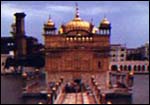

|
|
|
|
| HOME | TRAVEL | TRAVELOG | |||
 'It's an indescribable moment... ... the first view of the Golden Temple shimmering in the half light of the morning.'
Patwant Singh
I remember my sister and I -- we were staying in Delhi -- would visit Amritsar in the 1930s and every winter during the Christmas holidays we would go there to spend two weeks with my grandmother on Civil Lines. One of the greatest rituals in our life was getting up early in the morning, have a bath and go to the Darbar Sahib or the Golden Temple. We would leave the house by 5 or 6 am, the idea being to reach the place before dawn and to see the first rays of the rising sun over the shimmering pools around the Harmandir Sahib. We would travel in those days on horse carriages rather than cars and we would get out of the carriages and walk towards the archway, dip our feet in the pool of water before entering the hallowed precincts of the Harmandir Sahib. There would always be some flower sellers from whom we would buy flowers. And then with flowers in our hands we would go down the steps. That moment is still with me. It's an indescribable moment, I remember it created a deep impact on us even as a child when we had the first view of the Golden Temple shimmering in the half light of the morning and reflected in the blue water of the pool. And around the pool ,at many places, were people going down for an early morning dip. Mind you, it wasn't funny, for winters in Amritsar are harsh and cruel and we would find even taking a bath with warm water a tiresome prospect.
Then we would come out in front of the Akal Takht -- the temporal seat of Sikh gurus -- from where the Dakshani Deori or the causeway comes to the Harmandir. We would then step across the archway and enter the Harmandir Sahib from the left hand side. And we usually did a round again, bow our head before the Guru Granth Sahib -- Sikhs believe that the repository of knowledge is the ultimate guru -- where parties would be reciting shabadh round the clock except when the Harmandir was washed with milk every morning for few hours. Often, we would sit for a while and listen to the morning kirtans. The people who sang were devotees who had been coming to the Golden Temple for 60 or 70 years of their lives. Every day. It's like a magnet which draws people. It goes much beyond religion. It's a conviction that makes people realise that I need this for my peace of mind. Set to music the recitation from the Guru Granth Sahib have special appeal. But when I was young the significance of the written words hardly mattered except the music. As one grows old the understanding and comprehension becomes more enlarged. You came out wiser and more relaxed. It's amazing how a philosophy written centuries ago still have relevance. We would then sit there for as long as our parents wanted to, then get kara prasad, the sacramental food, and walk back to the Akal Takht, and then come back home. Visiting the Golden Temple, thus, was a very integral part of our holidays in Amritsar. We would often go to the temple in the evening again which would be a far different experience with more crowds and the change of light. But what stays in the mind is how across the water the sounds of the kirtans are reflected even before you enter the temple. Amritsar is basically a very Indian city, with closed, narrows streets and lanes around the temple with simple, unostentatious shops. Like Benares, it's a traditional old Indian city. Even the main bazaars like the Hal Bazaar were simple with big gates and fortified walls. Everyone seemed to know everyone. It had a very human scale. But time is changing everything. It is a great destroyer of tradition. Unless people wake up to their traditions and learn to conserve it. It is a pity that the government has knocked down the shops around the Golden Temple. The city is an integral part of the shrine, it grew around it. I am very distressed to hear about all the destruction of the beauty and the value of old Amritsar. It is like removing the old people from the family. You shouldn't do a surgical job on tradition. Patwant Singh, author and designer, spoke to Amrapali Singh.
|
|
|
Tell us what you think of this feature
|
|
|
HOME |
NEWS |
BUSINESS |
CRICKET |
MOVIES |
CHAT
INFOTECH | TRAVEL | LIFE/STYLE | FREEDOM | FEEDBACK |
|